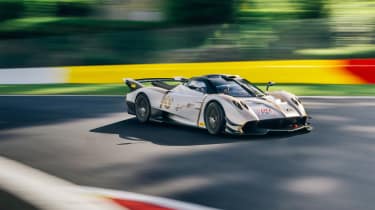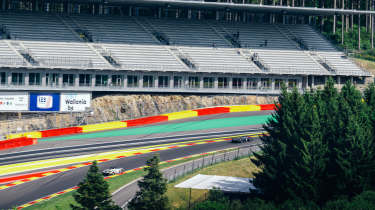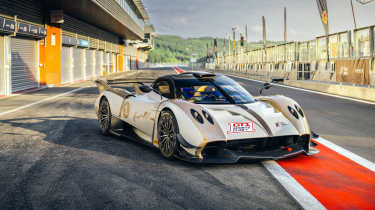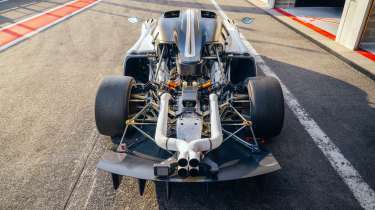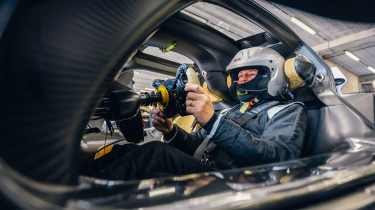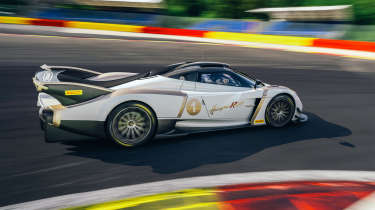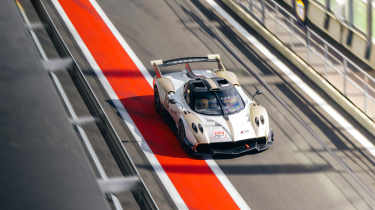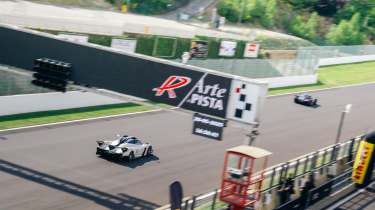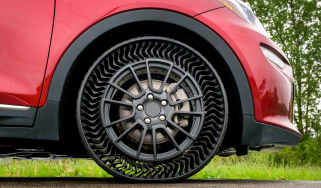Pagani Huayra R Evo Roadster 2025 review – the ultimate V12 track car
The Pagani Huayra R evo Roadster intensifies the V12 and brings the driver closer to its fury. The result is predictably compelling
Standing trackside at Spa, watching the spectacular new Pagani Huayra R Evo Roadster scream headlong towards the legendary swoop through Eau Rouge and Raidillon, I’m reminded of Enzo Ferrari’s famous quote about his customers only paying for the V12 engine and getting the rest of the car for free.
From where I’m standing, Horacio Pagani has gone one better, the Roadster’s unsilenced shriek alone worth every penny of the near £4million asking price. It’s all-consuming; the quality, clarity and sheer volume of the Huayra’s operatic exhaust note triggering a kind of euphoria. Stand here long enough and you will surely get drunk on decibels.
In a few short hours it’ll be me strapped into the long-tailed Huayra accelerating towards F1’s most evocative sequence of corners. To be completely honest it’s a thought that makes my guts tighten with apprehension, but until then I’m free to take my mind off things by enjoying my vicarious 24 hours as one of the ultra-high-net-worth individuals who count themselves amongst the select group of Pagani’s Arte in Pista clients.
As you’d expect, it’s an immaculate affair, but one that’s surprisingly laid-back. There are seven customer cars in attendance, plus the new Huayra R Evo Roadster, which is being made available to a small group of media over the next two days. Customers generally keep themselves to themselves, at least so far as mixing with the media is concerned, but there seems to be some friendly banter between them. All that’s missing is a sign on the wall saying, ‘You don’t have to be a billionaire to drive here, but it helps.’
More reviews
Pagani’s team is sizeable and encompasses technicians who are dedicated to individual cars, instructors who are assigned to owners for the day, and senior members representing Pagani and HWA (Pagani’s powertrain partner for the track-only cars), who oversee proceedings. It’s a slick operation geared to provide an effortless and unforgettable experience.
Skill levels amongst the customers are mixed. Some are clearly very new to the demands of slicks and wings, while others are more than capable of enjoying their cars to the full. Driver tuition is taken very seriously to keep people safe, but also to help customers maximise their potential and enjoy their cars. Andrea Montermini – F1 driver back in the ’90s and regular GT3 racer to this day – is the chief instructor. He also developed Pagani’s simulator, an example of which is set up in one of the pit garages for any of the drivers to use between sessions.
The Huayra R Evo Roadster is Pagani’s fifth track-only hypercar. As its name suggests, it is directly descended from the Huayra R, which was unveiled back in 2021 to coincide with the launch of Pagani’s exclusive Arte in Pista track-only customer events programme. It is also a more distant relative of Pagani’s earlier track-only Zonda-based trilogy, the Zonda R, R Evolution and Revolución.
Horacio’s cars have never been built to race, but Pagani’s limited track activity has created a special bloodline. This began back in 2003, albeit unofficially, when a privately entered Zonda S qualified for the Le Mans 24 Hours. Run with no support from the Pagani factory, it retired after ten laps due to a gearbox failure.
Subsequent track activities have received Horacio’s blessing. In 2007 a road-legal Zonda F Clubsport run by Pagani and driven by Ring specialist Marc Basseng set a new production car lap record around the Nordschleife of 7:27.82 to honour Fangio’s famous victory in the 1957 German Grand Prix. Then in 2010, Pagani and Basseng returned, this time with the Zonda R – Pagani’s first track-only model. Their target was the record for production-derived cars established by Ferrari and its 599XX. After some trials and tribulations, they duly beat it – by 11sec! – with a blistering 6:47.
> Best track day cars 2025 – the thrill of driving in its purest form
The ingredients that go to make the R Evo Roadster are mouth-watering. We’ll come to the bits Pagani designs and builds in a moment, but there’s no point denying that the heart of this wild confection is its sensational, naturally aspirated V12 engine. Designed and built by HWA (the motorsport arm of Mercedes-AMG), the 60-degree V12 is an entirely bespoke power unit, originally made from scratch for the Huayra R. Displacing 6 litres and developing 888bhp at 8750rpm, the Evo engine produces 50bhp more than the Huayra R’s and stretches the red line to 9250rpm thanks to new camshafts and revised (shorter) intake trumpets, along with new engine management calibration.
Speaking to Tobias Pfeiffer, HWA’s technical project manager, it’s clear the R Evo’s engine is a work of art. It owes nothing to the equally bespoke twin-turbocharged V12 built by AMG for Pagani’s Utopia road cars. Instead, it is derived from HWA’s Mercedes-badged 2-litre four-cylinder Formula 3 engines, along with Mercedes’ DTM and GT3 engines, particularly in the design of the valvetrain, combustion chambers and pistons.
Sharing the F3 engine’s 500cc cylinder capacity brings efficiency and packaging advantages. The 60-degree V-angle was chosen for its inherent smoothness – the V12 effectively operates as a pair of straight-sixes joined by a common crankshaft – and for its sound quality. There are no chains or belts, instead the engine is gear-driven like a mechanical watch.
It is mated to a six-speed sequential gearbox, the casing of which is designed by HWA and the internals supplied by Hewland. Service life for the engine, transmission and clutch is 10,000km. Pfeiffer says most Huayra Rs have covered between 4000 and 5000km in the last three years, so customers have many seasons of enjoyment before anything needs opening up.
And now it’s my turn. After an enjoyable and informative warm-up session on the simulator, it’s time to get ready. Walking back into the pit garage I’m struck by how fabulous the Roadster looks. The extravagant shape and exquisite finish might seem more LVMH than LMDh, but this ultimate Huayra packs similar performance to a Le Mans prototype. As well it might when you consider it has 888bhp, weighs 1060kg dry and can generate enough downforce to exceed the weight of the car once fluids, driver and a passenger are on board.
Pagani Automobili’s origins are founded on Horacio Pagani’s mastery of composites, so it’s no surprise that the R Evo Roadster showcases everything the company knows about building cars from carbonfibre. Signor Pagani has patented numerous composite materials, including the Carbo-Titanium HP62 G2 and Carbo-Triax HP62 used to construct the R Evo Roadster’s new monocoque and bodywork. As such, it is a lesson in lightness and strength.
Performance is a priority but safety is paramount for Pagani, which is why in addition to being faster than its predecessor, the R Evo Roadster is even safer. Particular attention has been paid to maximising side impact protection, and the seats and headrest structures are now moulded into the monocoque for maximum strength. There’s also an F1-style ‘halo’ with a central spar added to the roll structure for additional strength and protection for the driver and passenger.
Getting in high-silled cars like this can be an ungainly process, but it’s easier than it looks to thread yourself into the R Evo Roadster. Once in, you find the cockpit itself is beautifully appointed. It’s less intricate than Pagani’s road car interiors, but the ergonomic clarity and race-car vibe have not come at the expense of a luxury feel. All the exposed carbon is flawlessly finished and the fireproof upholstery looks and feels plush without seeming incongruous. The myriad switches on the steering yoke and centre console have beautifully positive haptics – perfect for operating with gloved hands – with their functions clearly illuminated once the ignition is switched on.
> Pagani Huayra Codalunga v Huayra Roadster BC – £10m of hypercar siblings go head-to-head
It’s now that you begin to appreciate that this car exists in its own zone. One carefully crafted and curated to combine the event of a race car with the reassuring fit, finish and familiarity of a luxury hypercar. It’s a clever and deliberate balance.
As for the Roadster bit, two new lift-out panels in the roof create a kind of targa top. It definitely lets more light and air into the cockpit (it also generates more downforce with the panels removed), but with a crash helmet on and your body pulled tight into the seat you are only aware of the slightest sliver of sky in your peripheral vision. Whether it lets more of that glorious exhaust note into the cockpit remains to be seen.
The starting ritual is a simple flick of a few toggles and the push of a starter button on the steering wheel. There’s no clutch pedal, so to move away you push the brake pedal then press a button marked ‘Drive’, which triggers the electronically managed clutch. Then all you do is release the brake, squeeze the throttle and pull away. It’s a smart solution (also managed by HWA) that spares both the clutch and your blushes.
We’re following Pagani’s test driver Andrea Palma, who’s setting the pace in a regular Huayra R. It should be daunting, but the R Evo Roadster is immediately friendly. Partly because the Pirelli slicks have just been pulled from their blankets, but mostly because the Roadster is so easy to operate. The steering is light but ultra-precise. Likewise, the Brembo CCMR brakes are great from the off and only gain in feel and bite as the pads and carbon discs come up to optimum temperature. The electronically actuated gearshift is gunshot-quick – Pfeiffer reckons it’s around 45 milliseconds – and the engine as sharp as a cut-throat razor. Such mechanical harmony is a rare and joyful experience.
Just as impressive is the multi-stage traction control. This too falls under the auspices of HWA; indeed Pfeiffer himself did the calibration work. It’s a brilliant system, holding the Roadster with soft hands to feel as natural as possible, but entirely trustworthy so you can really lean into it. With more laps I’d have wanted to relax it just a fraction for cleaner corner exits, but it’s perfectly judged for a car driven by experts and novices alike.
As you might imagine, the performance is epic. The engine is an absolute force of nature, silky smooth with plenty of torque (it sustains a peak of 568lb ft from 5800 to 8200rpm) to punch you out of the corners and a searing top-end that never stops gaining in intensity. Even with a relatively tentative run through Raidillon we’re pulling close to 190mph by the end of the long and slightly uphill Kemmel Straight. Crucially it sounds as good in the cockpit as it does from the spectator enclosures. Valkyrie take note.
Slicks and wings can be a daunting combination. In a pure race car they augment mechanical grip to extremes that require an uncomfortable leap of faith to access. Not so in the R Evo Roadster, which has been set up to remain consistent, communicative and progressive to encourage the exploration of its otherworldly capabilities.
To maintain a stable aerodynamic platform the R Evo features a heave damper on each axle. These additional dampers control the car’s vertical movement to keep the ride height as level and stable as possible, even under the load of 1300kg-plus of downforce at high speeds. The conventional springs and electronic dampers then manage individual wheel movements and control roll and pitch.
> Pagani Utopia 2025 review – £2.2m Huayra successor nails the hypercar formula
It makes for uncannily calm and transparent dynamics, yet with enough sense of connection that you feel able to up your commitment levels incrementally rather than take a deep breath and believe it will stick. It’s an exhilarating and addictive process. All too soon our session comes to an end. Much like Cinderella having to leave the ball before midnight, when I stop outside the pit box and shut the engine down, the Arte in Pista spell is broken. My vicarious day as a bazillionaire is done.
Prior to driving the R Evo Roadster I’d always wondered why you wouldn’t just buy an old LMP2 car and get a team to run you at some private test days on circuits of your choice. Now, having tried the car and experienced how the Arte in Pista events work, I can see the appeal of both the car and customer programme much more clearly.
Race cars are flighty, temperamental things, designed to meet specific regulations and built for pure competition. They are aggressive, highly sensitive to set-up changes and often intolerant of less-than-expert handling. They are a thrill, but their singularity of purpose only truly makes sense if you’re battling wheel-to-wheel with other drivers.
The R Evo Roadster is none of those things, and much the better for it. Factor in all the other elements that comprise Pagani’s Arte in Pista programme – sumptuous hotels, fine dining, first-rate technical support and one-to-one driver tuition – and the appeal is unique and undeniable.
Racing cars have a compelling authenticity that’s crystallised through competition, but the Huayra finds a different form of validation. That which comes from the exhilarating freedom of experiencing an incredible, unrestricted car purely for pleasure on some of the world’s greatest racetracks. Driving doesn’t get much better than this.
Pagani Huayra R Evo Roadster specs
| Engine | V12, 5980cc |
|---|---|
| Power | 888bhp @ 8750rpm |
| Torque | 568lb ft @ 5800-8200rpm |
| Weight | 1060kg (dry) (851bhp/ton) |
| Tyres | Pirelli P Zero slick |
| 0-62mph | c3.2sec |
| Top speed | 218mph |
| Basic price | c£3.9million |
